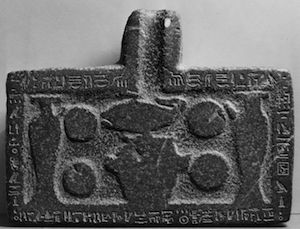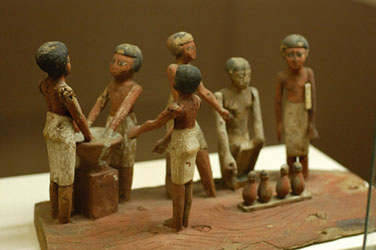
Beer was generally known as “Hqt” (“heqet” or “heket”) to ancient Egyptians, but was also called “tnmw” (“tenemu”) and there was a type of beer known as haAmt (“kha-ahmet”). The determinative of the word Hqt (beer) was a beer jug.


It is no exaggeration to say that beer was of central importance to ancient Egyptian society. Beer was enjoyed by both adults and children, was the staple drink of poor Egyptians but was also central to the diet of wealthy Egyptians. The gods were often made offerings of beer, and beer was mentioned in the traditional offering formula. Wages were often paid in beer (and other supplies) and the workmen living in the worker’s village at Giza received beer three times a day as part of their rations

There is some evidence that as a staple foodstuff, ancient Egyptian beer was not particularly intoxicating. Rather it was nutritious, thick and sweet. However, it is clear that beer could also be as intoxicating as Egyptian wine, as participants in the festivals of Bast, Sekhmet and Hathor would get very drunk as part of their worship of these goddesses. A popular myth tells how beer saved humanity when Sekhmet (in her role as the “Eye of Ra”) was tricked into drinking coloured beer which she mistook for blood and became very drunk, passing out for three days! Although the above three goddesses were closely associated with beer, it was Tjenenet who was the official ancient Egyptian goddess of beer.

According to legend, Osiris taught ancient Egyptians the art of brewing beer, but the brewing of beer was traditionally, though not exclusively, a female activity through which women could earn a little extra money (or bartered goods) for themselves and their families. The main ingredient in the beer was bread made from a rich yeasty dough possibly including malt. The bread was lightly baked and crumbled into small pieces before being strained through a sieve with water. Flavour was added in the form of dates and the mixture was fermented in a large vat and then stored in large jars.

There is also evidence that beer was brewed from barley and emmer which was heated and mixed with yeast and uncooked malt before being fermented to produce beer.
The glyph for a beer jug also appears in numerous words, including:
- “hotepet” – a bowl for bread offerings
- “iau wer” – breakfast
- “atkhu” – brewers
- “sur” – drink
- “hemu” – payment for employment
- “ahut” – gifs, food
- “hotep netjer” – gods offerings
- “khabbit” – jar
- “sejet” – beer jar
- “henu” – possessions, goods
- “set khet”, “shahbu” – meal
- “irtjet” – milk
- “meher” – milk jar
- “wedhu”, “hotep” – offering
- “mesyut” – supper
Beer also figures prominently in Egyptian literature and sayings. For example in this inscription dated to around 2200 BC…
“The mouth of a perfectly contented man is filled with beer”.
The following is from the Instructions of Ani:
“[your mother] sent you to school when you were ready to be taught writing, and she waited for you daily at home with bread and beer”.
Copyright J Hill 2010